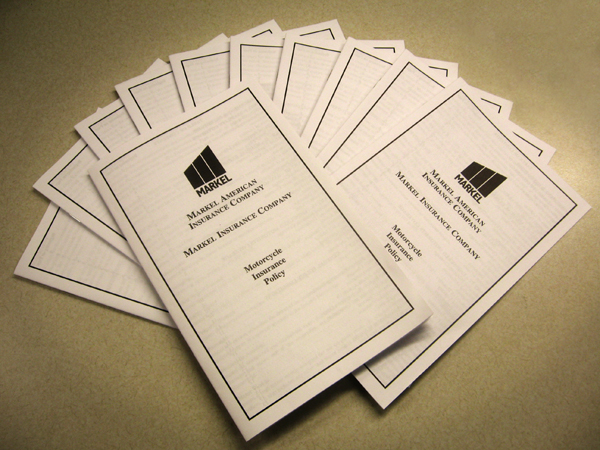
Insurance is a word that can incite many emotions; it can signify security, but it can also cause confusion when trying to understand what is and isnt covered under your policy when a loss occurs. As motorcycle insurance specialists we know just how mystifying this can be. This month, Ill share four of the more common misconceptions people have about their insurance and provide you with some real answers.
MISCONCEPTION: “Ive got health insurance. I dont need Medical Payment Coverage on my motorcycle policy.”
Many people decline medical payment coverage or “Med Pay” because they have a health insurance plan. They assume that the medical expenses due to injury resulting from a motorcycle accident will be covered 100 percent by their health insurance.

Med Pay, which is optional in most states, covers reasonable medical expenses (and also funeral expenses) if an accident were to occur, regardless of fault. It is typically secondary to an individuals health insurance, but can become the primary coverage if an individual does not have health insurance, or if they are on Medicare or Medicaid. Med Pay also helps with the out of pocket expenses that health insurance plans normally dont cover such as deductibles and co-pays –expenses that can add up in a hurry. Coverage amounts vary by state and insurance carrier, and usually apply to both you and any passenger on your motorcycle at the time of an accident, regardless of fault.24
It is very important to evaluate your insurance needs and optional coverages such as Med Pay before you purchase your policy because we have seen cases where an individual will lose their job, and subsequently their health insurance, and then have an accident. Without Med Pay, there may be little option to recoup any of your medical bills from the accident.
MISCONCEPTION: “My credit history has nothing to do with my insurance premium.”

A growing trend in the insurance industry is insurance scoring, and its use to determine an individuals insurance rate as insurance scores have been proven to reliably predict an individuals likelihood of filing an insurance claim. Dont confuse an insurance score with a credit score, though. The risk of filing an insurance claim is different than a credit risk. For example, income is not used in developing your insurance score although “responsibility type factors” may be used such as a persons credit card payment history, number of revolving accounts, number of
new accounts, the presence of collection accounts, bankruptcies, foreclosures, etc.
Many insurance companies use a third party that has developed a mathematical algorithm to help assign insurance scores. The algorithm looks for certain patterns of behavior in a persons credit history to identify predictive characteristics of loss. The insurance company will then assign weights to these specific characteristics to arrive at the insurance score.
A few important things to note about insurance scoring:Insurance scoring does not take into account things such as income, education, ethnicity, age or gender; its more of a measure of financial responsibility.Unlike credit checks when applying for a loan, insurance scoring is a “soft hit” inquiry on your credit and does not affect your credit score. While many insurance companies may have access to your insurance score, they do not actually see your credit score. While the majority of states do, not all states allow for insurance scoring.
Each insurance company may have different reasoning for why they do or do not use insurance scoring, but given all the factors considered when developing an insurance score, it is a reliable predictor of a person’s behavior allowing for better alignment when setting insurance rates.
MISCONCEPTION: “Comprehensive and collision coverage are interchangeable.”

Two of the more commonly used terms throughout the insurance industry are comprehensive and collision. People often think that “comprehensive” covers everything when in fact it doesnt. Collision coverage provides protection for the physical damage to your bike when it hits or is hit by another vehicle or object.
Because it doesnt always take two vehicles to create an accident, comprehensive coverage provides protection for damage not caused by collision and usually covers things such as theft, fire, vandalism, weather damage, or hitting an animal.
You should also know that while comprehensive and collision are both optional coverages, most lien-holders do require them and for good reason. But a lein-holder requirement is not the only reason to have comprehensive and collision coverage. Comprehensive and collision coverages are designed to help get your bike fixed and back on the road. If you are in an accident on a motorcycle, chances are there will be some damage. It is also important to note that damage done to someone elses vehicle or property would not be covered under collision and/or comprehensive, but under liability coverage (see June article).
MISCONCEPTION: “My driving record in my car has nothing to do with my motorcycle insurance.”

When shopping for insurance for your bike, you will usually be asked to disclose any accidents and/or violations you have had in the last three years. Statistically speaking, a persons driving behavior is consistent whether in a car or on a bike, so someone with multiple accidents and/or violations is considered a bigger insurance risk. Because of this increased risk, your insurance rates will most likely be higher than if you had a clean driving record.
Fortunately, “behavior” type factors can also work in your favor. Preventative measures such as taking motorcycle safety courses will also be taken into consideration when obtaining an insurance quote and could qualify you for discounts on your premium.
Related Articles:
Motorcycle Insurance: 5 Commonly Asked Questions
Insuring Your Motorcycle Accessories: Five steps to make sure the extras are covered

Dear Shirley,
Under Markel American Insurance policies, dirt bikes are afforded the same consideration as a street legal motorcycle.
You do raise a very good point in that each state (and country) has its own unique laws and regulations where insurance coverage is concerned. Unfortunately, I cannot speak to how policies originating in Canada are written or how they respond when traveling to the United States. I am not aware of any state that limits motorcycles to no fault claims of $10,000, but no-fault laws may require a “threshold” be met before an individual can proceed against the party causing the accident; such a threshold can either be the nature of the injury or amount of damages. I invite you to contact us directly should you want to discuss in more detail.
As for crossing state lines with one of our policies within the US: our policies respond to the unique requirements of each state for the purpose of Liability. For example, if the policyholder had Bodily Injury and Property Damage Liability limits of 15/30/10 and the insured had an at-fault accident in another state where the minimum required limits were 50/100/25; our policy would provide liability coverage up to the 50/100/25 limits of the state where the accident occurred. All other non-liability coverages will maintain the same limits as shown on the policyholder’s declarations page.
Good article covering the basics for street machines. What about dirt bike insurance? In either case, you have left out the issue of the many at fault states that limit all motorcycles to no fault claims of $10,000. This does not go far in a catastrophic accident. It is hard to find out in what states an out of state/country rider will require extra insurance for, something you should know before you cross the country on a bike.
A well written “must read” nuts and bolts article about insurance for you and your bike. Unfortunately most people learn this stuff after the fact which can be an extraordinarily expensive lesson! Care to guess how I know?